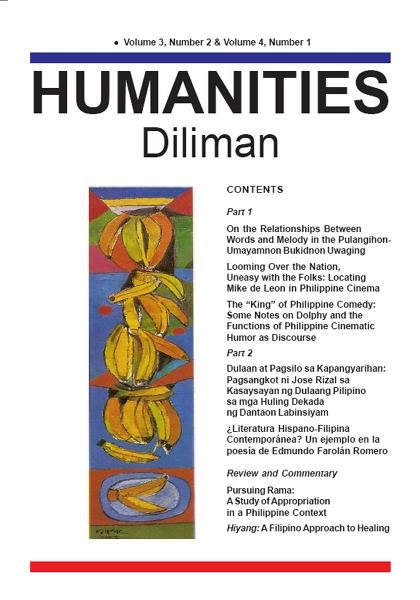On the Relationships Between Words and Melody in the Pulangihon-Umayamnon Bukidnon <I>Uwaging</I>
Abstract
Singers of indigenous, long narratives in the Philippines employ a number of tunes in setting the verses. In this paper, I examine the tunes that Datu Sinuhoy Kaligunan utilized in his UWAGING performance, lasting near 11 hours, that I recorded in May 2005. Datu Sinuhoy is a Pulangihon-Umayamnon Bukidnon speaker. His tunes are named according to: (1) non-lexical formulaic expressions, (2) the places where the tunes are perceived to originate, and (3) even names of individual beings–persons and spirits–from those places.An investigation of the recording of the Pulangihon-Umayamnon uwaging performance in its entirety reveals that some tunes are used to project the moods and feelings attendant to the actions of the narrative but they are not emblematic of the characters in the narrative per se as in the Palawan TULTUL. I argue that tunes are important in uwaging performance for they facilitate the linear grouping of words into verse units that generally span eight (musical) pulses, each of which is assigned one syllable each. Like most epics in the Philippines (e.g., ULLALIM, GASUMBI, HUDHUD, KATA-KATA, ULAGING, UWAEGING of Agusan Manobos), Pulangihon-Umayamnon Bukidnon uwaging has prosodic features that fit euphoniously with the tunes (e.g., the shapes of the tunes reinforce the sound parallelisms in the words). In addition, like the versions of the epic in Bukidnon, the Pulangihon-Umayamnon uwaging can be recited, MANTUKAW, minus the melody. This fact implies an important corollary; the internalization of uwaging prosody is acquired separately from the setting of words to tunes. In fact, singers internalize the prosody of the verses by reciting them from the memory of other singers’ performances, attempting to intone them (with the formulaic tunes) only after they have mastered and memorized a fair amount of verses. In my fieldwork, Datu Sinuhoy dictated to my linguistic assistant a set of textual epithets forming poems called “unturan ne ngaran” (what singers call in Cebuano, the lingua franca of the place, as “tag-as nga pangalan” or “long names”). This was done separately after the complete recording of the uwaging. This evidence suggests that Pulangihon-Umayamnon Bukidnon uwaging performance entails elaborate, pre-performance compositional activities, in which singers internalize the physical [read: material] sonic qualities of the epic. These studies enable singers to produce what Pulangihon-Umayamnon Bukidnon call SAMPAH ‘balance,’ a local ethnopoetic concept of beauty in the voice of sung story.
Published
2007-12-04
How to Cite
BUENCONSEJO, José S..
On the Relationships Between Words and Melody in the Pulangihon-Umayamnon Bukidnon Uwaging.
Humanities Diliman: A Philippine Journal of Humanities, [S.l.], dec. 2007.
ISSN 2012-0788.
Available at: <https://journals.upd.edu.ph/index.php/humanitiesdiliman/article/view/626>. Date accessed: 02 sep. 2025.
Section
Articles
Keywords
epic song, orality, voice, improvisation, verbal art, indigenous art


